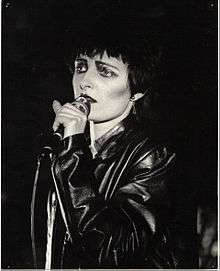Women in punk rock

Women have made significant contributions to punk rock music and its subculture since its inception in the 1970s.[1][2] In contrast to the rock music and heavy metal scenes of the 1970s, which were dominated by men, the anarchic, counter-cultural mindset of the punk scene in mid-and-late 1970s encouraged women to participate. This participation played a role in the historical development of punk music, especially in the U.S. and U.K. at that time, and continues to influence and enable future generations.[3] Women have participated in the punk scene as lead singers, instrumentalists, as all-female bands, zine contributors and fashion designers.[4]
Rock historian Helen Reddington states that the popular image of young punk women musicians as focused on the fashion aspects of the scene (fishnet stockings, spiky blond hair, etc.) was stereotypical. She states that many, if not all women punks were more interested in the ideology and socio-political implications, rather than the fashion.[5][6] Music historian Caroline Coon contends that before punk, women in rock music were virtually invisible; in contrast, in punk, she argues, "It would be possible to write the whole history of punk music without mentioning any male bands at all – and I think a lot of [people] would find that very surprising."[7][8]
Johnny Rotten wrote that "During the Pistols era, women were out there playing with the men, taking us on in equal terms ... It wasn’t combative, but compatible."[9] Chrissie Hynde echoed similar sentiments when discussing her start in the punk scene, "That was the beauty of the punk thing: [sexual] discrimination didn't exist in that scene."[10] The anti-establishment stance of punk opened the space for women who were treated like outsiders in a male-dominated industry. Sonic Youth's Kim Gordon states, "I think women are natural anarchists, because you're always operating in a male framework."[11]
Others take issue with the notion of equal recognition, such as guitarist Viv Albertine, who stated that "the A&R men, the bouncers, the sound mixers, no one took us seriously.. So, no, we got no respect anywhere we went. People just didn't want us around."[12][13]
History
Context
Women have a high prominence in many popular music styles as singers. However, professional women instrumentalists are uncommon in popular music, especially in rock genres such as heavy metal. The lower participation by women as instrumentalists bands is caused in part because "playing in a band is largely a male homosocial activity, that is, learning to play in a band is largely a peer-based... experience, shaped by existing sex-segregated [male] friendship networks.[14] As well, rock music "...is often defined as a form of male rebellion vis-à-vis female bedroom culture."[15]
In popular music, there has been a gendered "distinction between public (male) and private (female) participation" in music.[15] "[S]everal scholars have argued that men exclude women from bands or from the bands' rehearsals, recordings, performances, and other social activities."[16] "Women are mainly regarded as passive and private consumers of allegedly slick, prefabricated – hence, inferior – pop music..., excluding them from participating as high status rock musicians."[16] One of the reasons that there are rarely mixed gender bands is that "bands operate as tight-knit units in which homosocial solidarity – social bonds between people of the same sex... – plays a crucial role."[16] In the 1960s pop music scene, "[s]inging was sometimes an acceptable pastime for a girl, but playing an instrument...simply wasn't done."[17]
"The rebellion of rock music was largely a male rebellion; the women—often, in the 1950s and '60s, girls in their teens—in rock usually sang songs as personæ utterly dependent on their macho boyfriends...". Philip Auslander says that "Although there were many women in rock by the late 1960s, most performed only as singers, a traditionally feminine position in popular music". Though some women played instruments in American all-female garage rock bands, none of these bands achieved more than regional success. So they "did not provide viable templates for women's on-going participation in rock".[18]:2–3 In relation to the gender composition of heavy metal bands, it has been said that "[h]eavy metal performers are almost exclusively male"[19] "...[a]t least until the mid-1980s"[20] apart from "...exceptions such as Girlschool."[19] However, "...now [in the 2010s] maybe more than ever–strong metal women have put up their dukes and got down to it",[21] "carv[ing] out a considerable place for [them]selves."[22]
When Suzi Quatro emerged in 1973, "no other prominent female musician worked in rock simultaneously as a singer, instrumentalist, songwriter, and bandleader".[18]:2 According to Auslander, she was "kicking down the male door in rock and roll and proving that a female musician ... and this is a point I am extremely concerned about ... could play as well if not better than the boys".[18]:3
1970s
Patti Smith
.jpg)
Patti Smith (born 1946) is a groundbreaking New York City punk rock singer/songwriter, poet and artist, whose first album, Horses (1975), significantly influenced the New York City punk rock genre. Smith's work went on to receive international recognition. In 2007 she was inducted into the Rock and Roll Hall of Fame.[23] She was born Patricia Lee Smith in Chicago, Illinois, U.S.
Chrissie Hynde
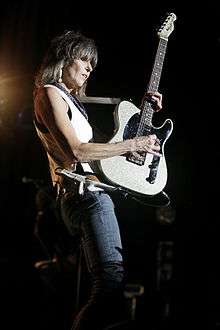
Chrissie Hynde (born 1951 in Akron, OH) is a singer, songwriter and guitar player and co-founder of the band, The Pretenders.[24] They were inducted into the Rock & Roll Hall of Fame in 2005.
Siouxsie Sioux
Born Susan Janet Ballion in 1957 in Southwark, England, Siouxsie Sioux is best known as the lead singer of Siouxsie and the Banshees, releasing eleven studio albums. She continued to tour with The Creatures before embarking on a solo career.
Nina Hagen

Catharina Hagen (born 1955), known as the German singer, Nina Hagen, was born in East Berlin, German Democratic Republic. After working with the band, Automobil, she became a solo artist, and released her first solo album NunSexMonkRock in 1982.[25] This was followed by the 1983 album, Fearless and in 1985, Ekstasy.
Exene Cervenka
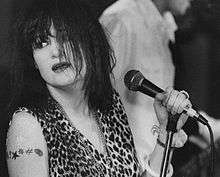
Exene Cervenka co-founded the band X in 1977, with John Doe, Billy Zoom and DJ Bonebrake. Their album, Los Angeles (date) established her as a presence as a powerful vocalist in the punk rock movement.[26]
Joan Jett

Joan Jett, born Joan Marie Larkin, and her all-female band, The Runaways was started when she was still in high school, and had several "hits" such as Cherry Bomb and American Nights. In the 1980s she founded her own independent label, Blackheart Records.[27] She was inducted into the Rock & Roll Hall of Fame in 2015.
Lydia Lunch
Lydia Lunch, began her career as the frontwoman for the band, Teenage Jesus and the Jerks, and went on to collaborate with numerous other musicians and bands, including Nick Cave, Sonic Youth, Brian Eno, among others.
Poly Styrene
Poly Styrene (1957-2011) founded the punk band X-Ray Spex, whose 1978 album, Germ Free Adolescents established her as a strong contributor as front woman, singer-songwriter and musician.
Ari Up
Ari Up (1962-2010), was born Ariane Daniela Forster in Munich, Germany, and was a vocalist and member of The Slits a British punk rock band. She took guitar lessons from Joe Strummer of The Clash.[28][29]

Gaye Advert
British born Gaye Advert, also known as Gaye Black, was the bass player for The Adverts. She has been called, "one of punk's first female icons", and the "first fema[le] punk star."[30][31]
Palmolive
Paloma McLardy (born 1955) is known as the drummer and songwriter for The Slits, as Palmolive. Born in Spain, she moved to London in 1972 to live in the squats with other counter-cultural youths.[32] In London, she befriended Joe Strummer of The Clash who introduced her to Sid Vicious, bass player for the Sex Pistols. Through these alliances she joined the band The Flowers of Romance with guitarist Viv Albertine. Having met 14-year old Ari Up at a Patti Smith concert, they formed the all-women punk band, The Slits, playing gigs with The Clash, the Sex Pistolsthe Buzzcocks and others. In 1979, she joined the all female punk band, The Raincoats who recorded an album for Rough Trade Records.[33]
Poison Ivy
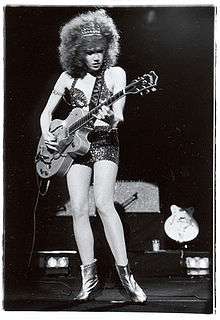
Poison Ivy (born 1953) is Californian who is known for her work as a guitarist and songwriter who co-founded the American punk-rockabilly band, The Cramps. Also known as Poison Ivy Rorschach she was born Kristy Marlana Wallace. She also provided vocals, as well as arranging songs and producing records. At Sacramento State College she met Lux Interior (born Erick Lee Purkhiser) in 1972, who became the singer for The Cramps, whose work gained a cult following as well a course of European commercial success.[34][35]
Debbie Harry
_One.jpg)
Debbie Harry is one of the most commercially successful musicians of punk rock/new wave. Her band, Blondie, often performed at CBGB in New York City, and their 1978 album, Parallel Lines, is considered a punk-pop classic.[36] Harry's band, Blondie was inducted into the Rock & Roll Hall of Fame in 2006.
Viv Albertine
Viv Albertine (born 1954, in Sydney, Australia) is a guitarist and singer for the British punk band, the Slits. Albertine was part of the inner circle of the punk bands the Clash and the Sex Pistols, and joined the Slits in 1977. She has also played with the post-punk band, Flying Lizards, the dubstep-influenced New Age Steppers and the punk band, The Flowers of Romance (band).[37]
1980s
Lene Lovich

Lene Lovich is an American-born English singer, known for her idiosyncratic vocal style. Although active in 1978 & 1979, much of her success was in the 1980s. Her debut studio album Stateless (1978), which produced the single "Lucky Number".[38] She released two more albums, Flex (1979) and No Man's Land (1982), on Stiff Records. In 1989, she independently released the album March, before her 15-year hiatus.
Kim Gordon
The American bassist and singer, Kim Gordon (born 1953) and her band, Sonic Youth were formed in 1981, establishing her as an important presence in the downtown New York City music scene. She wrote and performed music with Sonic Youth through 2012. Her memoir, Girl in a Band was published in 2015.[39]
Lydia Lunch
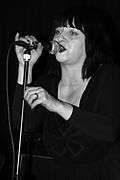
Lydia Lunch (born 1959) is a US punk rock and No Wave singer. Her career was established with the founding of Teenage Jesus and the Jerks in collaboration with James Chance. In the mid-1980s she formed Widowspeak, a recording and publishing company.[40]
Wendy O. Williams
Wendy O. Williams (1949-1998) was the lead singer and songwriter for the punk band, Plasmatics whose performances included such actions as chain-sawing guitars and blowing up equipment on stage.[41]
Debora Iyall
Debora Iyall was the lead singer in the San Francisco-based punk bank, Romeo Void.[42] She was born in Washington state and is of Cowlitz Native American heritage.[43]
1990s
Riot Grrrl

Riot grrrl is an underground feminist hardcore punk movement that originally started in the early 1990s, in Washington, D.C.,[44] and the greater Pacific Northwest, noticeably in Olympia, Washington.[45] It is often associated with third-wave feminism, which is sometimes seen as its starting point. It has also been described as a musical genre that came out of indie rock, with the punk scene serving as an inspiration for a musical movement in which women could express themselves in the same way men had been doing for the past several years.[46]
Riot grrrl bands often address issues such as rape, domestic abuse, sexuality, racism, patriarchy, and female empowerment. Bands associated with the movement include Bikini Kill, Bratmobile, Heavens to Betsy, Excuse 17, Huggy Bear, Cake Like, Skinned Teen, Emily's Sassy Lime, Sleater-Kinney, and also queercore groups like Team Dresch.[47][48] In addition to a music scene and genre, riot grrrl is a subculture involving a DIY ethic, zines, art, political action, and activism.[49] Riot grrrls are known to hold meetings, start chapters, and support and organize women in music.[50]
Kathleen Hanna

Kathleen Hanna (born 1968) and Tobi Vail co-founded the band, Bikini Kill, establishing the feminist riot grrrl movement. Hanna has also released an album under the name Julie Ruin, which developed into Le Tigre.[51]
PJ Harvey
PJ Harvey (born 1969) is an English performers associated with the punk blues and alternative rock movements.[52]
The Breeders
The Breeders are an American band formed in 1990 by Kim Deal of the Pixies, her twin sister Kelley Deal and Tanya Donelly of Throwing Muses. The band has experienced a number of lineup changes; Kim Deal has been the band's sole continual member. Their first album, Pod (1990), though not commercially successful, received wide critical acclaim. The Breeders' most successful album, Last Splash (1993), is best known for the hit single "Cannonball".[53]
Elastica
Elastica were an English band best known for their 1995 album Elastica, which produced singles that charted in the United Kingdom and the United States.[54]
Republica

Republica are an English band formed in 1994, featuring their lead singer Saffron. Republica are best known for their hit single, "Ready to Go". Their music is described as dance punk or technopop punk rock.
Hole
Hole was formed Los Angeles, California in 1989 by singer and guitarist Courtney Love and lead guitarist Eric Erlandson. The band had a revolving line-up of bassists and drummers, their most prolific being drummer Patty Schemel, and bassists Kristen Pfaff (d. 1994) and Melissa Auf der Maur.[55]
2000s
Carrie Brownstein
Carrie Brownstein (born 1974) rose to prominence by establishing the riot grrrl all-women punk band Sleater-Kinney with Corin Tucker and Janet Weiss.[56]
Pussy Riot
Formed in 2011 as a punk band, artist collective and activist group.[57]
Laura Jane Grace
.jpg)
Laura Jane Grace (born Thomas James Gabel, born 1980) is an American transgender musician who is the founder, guitarist and lead singer, songwriter and of the punk band Against Me!. [58]
List of other women punk musicians
- Patricia Morrison
- Tessa Pollitt
- Pat Place
- Alice Bag
- Caroline Azar
- Lunachicks
- June Miles-Kingston
- Sara Lee
- Little Annie Anxiety Bandez
- Honey Bane a.k.a. Donna Tracy Boylan
- Bif Naked a.k.a. Beth Torbert
- Christina Billotte
- Kat Bjelland* Sugar Babydoll a.k.a. Jennifer Finch
- Cinder Block a.k.a. Cindy Morgan
- Corin Tucker
- Patti Smith Group
- The Pretenders
- Siouxsie and the Banshees
- X
- Joan Jett and the Blackhearts
- Blondie
- Mo-dettes
- The Slits
- X-Ray Spex
- Au Pairs
- The Nips
- The Raincoats - Gina Birch (bass, vocals), Ane de Silva (guitar, vocals), Palmolive (drums) Vicki Aspinall (violin)
- Sleater-Kinney
- H.U.M.A.N.W.I.N.E. - Holly Brewer
- Wild Flag
- Delta 5
- Babes in Toyland
- Rubella Ballet
- L7
- Kim Deal
- Kelly Deal
- The Breeders
- The Pixies
- Suzi Gardner
- Donita Sparks
- Jennifer Finch
- Dee Plakas
- Heavens to Betsy
- Fabulous Disaster
- Tilt - Cinder Block
- Becca Albee
- Excuse 17
- Romeo Void
- Retching Red
- Dolly Mixture
- The Gymslips
- The Belle Stars
- Bags
- Fifth Column
- Men They Couldn't Hang
- Poison Girls
- Fatal Microbes
- Autoclave
- Essential Logic
- Marine Girls
- Quix*o*tic
- Shanne Bradley
- Beki Bondage
- Lora Logic
- Suzi Gutsy a.k.a. Suzi Webb
- Kate Korus a.k.a. Katherine Korris
- Katastrophy Wife
- Brody Dalle
- Bratmobile
- Le Tigre
- Courtney Love
- Mia Zapata
- Excuse 17
- Cherie Currie
- Jemina Pearl
- Penelope Houston
- Kim Shattuck
- Heavens to Betsy
- Cherry Vanilla
- Marie Currie
- Kaia Wilson
- Yanka Dyagileva
- Phranc
- Patricia Morrison
- Regina Zernay Roberts
- Brix Smith
- Theo Kogan
- Jody Bleyle
- Nomy Lamm
- Phew (singer)
- Bleach (Japanese band)
- Subway Sect
- the Subversives
- London (band)
- Chelsea (band)
- Generation X (band)
- Penetration (band)
- Pauline Murray
- Elli Medeiros
- Debora Iyall
- Mecca Normal
- Jackie Fox
- Beth Ditto
- Bush Tetras
- Pat Place
- Jayne County
- Lene Lovich
- Goodbye Mr. Mackenzie Shirley Manson
- Garbage
- Free Kitten
- Lorna Doom
- Kira Roessler
- Amanda X
- Frau (band)
- Sharkmuffin
Fashion
A designer associated with early UK punk fashion in the 1970s was Vivienne Westwood, who made clothes for Malcolm McLaren's boutique in the King's Road, which became famous as "SEX". Other designers included Wendy Gawitz and Kate Buck of "Eccentric Clothing" in Collingwood; Melbourne, Australia designers Julie Purvis and Jillian Burt, and fellow Australians Kate Durham and Sara Thorn.[59]
Women in the hardcore punk scene typically wore army pants, band T-shirts, and hooded sweatshirts.[60] The style of the 1980s hardcore scene contrasted with the more provocative fashion styles of late 1970s punk rockers (elaborate hairdos, torn clothes, patches, safety pins, studs, spikes, etc.).
Social change
The Mexico City-based punk rock collective, Hijas de Violencia (the Daughters of Violence) conduct street performances to combat harassment of women.[61]
See also
- All-female band
- Women in music
- Punk rock
- Riot grrrl
- Girlschool, a pioneering speed metal band.
References
- ↑ Coon, Caroline (1977). 1988: The New Wave Punk Rock Explosion. London: Omnibus/Hawthorne Books. ISBN 978-0801561290.
- ↑ Berman, Judy. "15 Essential Women Punk Rock Icons". Flavorwire. Retrieved 25 November 2015.
- ↑ "Why Women in Punk?". Women in Punk. Punk77.co.uk. Retrieved 26 November 2015.
- ↑ Raha, Maria (2004). Cinderella's Big Score: Women of the Punk and Indie Underground. Seal Press. ISBN 978-1580051163.
- ↑ Reddington, Helen (2012). The Lost Women of Rock Music: Female Musicians of the Punk Era. Ashgate/Equinox Publishing. ISBN 978-1845539573. Retrieved 26 November 2015.
- ↑ Woronzoff, Elizabeth. "The Lost Women of Rock Music' Is an Important Work, But a Replay of the Same Old Themes". Pop Matters. Retrieved 26 November 2015.
- ↑ Conference proceedings (September 2001). "No Future?". University of Wolverhampton.
- ↑ Reddington, Helen (1977). Introduction: The Lost Women of Rock Music (PDF). London: Ashgate. ISBN 9780754657736.
- ↑ Lydon, John (1995). Rotten: No Irish, No Blacks, No Dogs. London: Coronet. p. 378. ISBN 978-0312428136.
- ↑ George-Warren, Holly (November 13, 1997). "Q&A: Chrissie Hynde". Rolling Stone. Retrieved December 22, 2015.
- ↑ Hall, Rock. "Women Who Rock: 10 Essential Punk Songs". The Rock & Roll Hall of Fame Museum. Retrieved 27 November 2015.
- ↑ Petridis, Alexis. "The Slits' Viv Albertine on punk, violence and doomed domesticity". The Guardian. Retrieved 27 November 2015.
- ↑ Andrews, Charlotte Richardson (July 3, 2014). "Punk has a problem with women. Why?". The Guardian. Retrieved 27 November 2015.
- ↑ Julian Schaap and Pauwke Berkers. "Grunting Alone? Online Gender Inequality in Extreme Metal Music" in Journal of the International Association for the Study of Popular Music. Vol.4, no.1 (2014) p. 101-102
- 1 2 Julian Schaap and Pauwke Berkers. "Grunting Alone? Online Gender Inequality in Extreme Metal Music" in Journal of the International Association for the Study of Popular Music. Vol.4, no.1 (2014) p. 102
- 1 2 3 Julian Schaap and Pauwke Berkers. "Grunting Alone? Online Gender Inequality in Extreme Metal Music" in Journal of the International Association for the Study of Popular Music. Vol.4, no.1 (2014) p. 104
- ↑ White, Erika (2015-01-28). "Music History Primer: 3 Pioneering Female Songwriters of the '60s | REBEAT Magazine". Rebeatmag.com. Retrieved 2016-01-20.
- 1 2 3 Auslander, Philip (28 January 2004). "I Wanna Be Your Man: Suzi Quatro's musical androgyny" (PDF). Popular Music. United Kingdom: Cambridge University Press. 23 (1): 1–16. doi:10.1017/S0261143004000030. Retrieved 25 April 2012.
- 1 2 Brake, Mike (1990). "Heavy Metal Culture, Masculinity and Iconography". In Frith, Simon; Goodwin, Andrew. On Record: Rock, Pop and the Written Word. Routledge. pp. 87–91.
- ↑ Walser, Robert (1993). Running with the Devil:Power, Gender and Madness in Heavy Metal Music. Wesleyan University Press. p. 76.
- ↑ Eddy, Chuck (1 July 2011). "Women of Metal". Spin. SpinMedia Group.
- ↑ Kelly, Kim (17 January 2013). "Queens of noise: heavy metal encourages heavy-hitting women". The Telegraph.
- ↑ "Patti Smith". Rock and Roll Hall of Fame Museum. Retrieved 25 November 2015.
- ↑ Light, Alan (October 3, 2008). "Her City's Not Gone, and Neither is She". The New York Times. Retrieved 25 November 2015.
- ↑ Metzger, Richard. "Pre-punk Nina Hagen in East Germany, 1974". Dangerous Minds. Retrieved 25 November 2015.
- ↑ Facroski, Kelli Skye (August 21, 2013). "Exene tells it straight on X, illness and O.C.". The Orange County Register. Retrieved 25 November 2015.
- ↑ Popson, Tom (October 7, 1988). "Top 10 Again, Joan Jett Looks at the State of Rock". Chicago Tribune. Retrieved 25 November 2015.
- ↑ Robb, John (October 21, 2010). "Ari Up obituary: The Slits frontwoman, she helped to reinvent women's role in music". The Guardian. Retrieved 25 November 2015.
- ↑ Kreps, Daniel (October 21, 2010). "Ari Up, of the Punk Band the Slits, dies at 48". Rolling Stone. Retrieved 25 November 2015.
- ↑ Strong, M.C. (2003). The Great Indie Discography. Edinburgh: Canongate Books. ISBN 1-84195-335-0.
- ↑ Larkin, Colin (2002). The Virgin Encyclopedia of 70s Music. London: Virgin Books. ISBN 1-85227-947-8.
- ↑ Gallix, Andrew (2005). "Untypical Girl". 3:AM Magazine. Retrieved 9 December 2015.
- ↑ Berger, Melody (2014). "The Pilgrimage of Palmolive". Tom Tom Magazine. Special Issue on Spirituality and Religion (February 2014). Retrieved 9 December 2015.
- ↑ Garry Mulholland (December 2006). "Aloha from hell! The grave tale of a dead serious rock’n’roll band" (Article). The Stool Pigeon. Thestoolpigeon.co.uk. Retrieved 7 May 2012.
- ↑ Pius (23 February 1992). "Poison Ivy 1992 Interview" (Interview). PENETRATING INSIGHTS. Nonozeroblog.blogspot.com. Retrieved 7 May 2012.
- ↑ "Blondie Biography". Rock and Roll Hall of Fame Museum. Retrieved 25 November 2015.
- ↑ Parkhouse, Will (February 25, 2010). "I Do Not Believe In Love: Viv Albertine On Life Post The Slits". The Quietus. Retrieved 18 July 2017.
- ↑ Juneau, Jason. "Innovation in New Wave: Lene Lovich", Perfect Sound Forever, September, 2001.
- ↑ Hyman, Dan (September 12, 2013). "Q&A: Kim Gordon on Her New Bankd Body/Head and Missing Sonic Youth". Rolling Stone. Retrieved 25 November 2015.
- ↑ Calhoun, Ada (December 20, 2013). "Lydia Lunch Through the Years". The New York Times. Retrieved 25 November 2015.
- ↑ Strauss, Neil (April 9, 1998). "Wendy O. Williams, 48, Star of Explosive Punk Rock Act". The New York Times. Retrieved 25 November 2015.
- ↑ Evans, Kirsty. "Debora Iyall Fills a Void". East Bay Express. East Bay Express. Retrieved 12 February 2016.
- ↑ Lanham, Tom (June 10, 2011). "Debora Iyall from Romeo Void is back with ‘Stay Strong’". San Francisco Examiner. Retrieved 13 February 2016.
- ↑ http://www.sheknows.com/entertainment/articles/1080646/its-riot-grrrl-day-in-boston-here-are-songs-to-rock-out-to-at-work
- ↑ Feliciano, Steve. "The Riot Grrrl Movement". New York Public Library.
- ↑ Marion Leonard. "Riot grrrl." Grove Music Online. Oxford Music Online. Oxford University Press. Web. 20 July 2014.
- ↑ "List of Riot Girl Bands". Hot-topic.org. Archived from the original on 23 February 2009. Retrieved 30 September 2012.
- ↑ Meltzer, Marisa (15 February 2010). Girl Power: The Nineties Revolution in Music. Macmillan. p. 42. ISBN 9781429933285.
- ↑ Jackson, Buzzy (2005). A Bad Woman Feeling Good: Blues and the Women Who Sing Them. New York: W.W. Norton. ISBN 978-0-393-05936-6.
- ↑ Schilt, Kristen (2003). ""A Little Too Ironic": The Appropriation and Packaging of Riot Grrrl Politics by Mainstream Female Musicians" (PDF). Popular Music and Society. 26 (1): 5. doi:10.1080/0300776032000076351.
- ↑ Frere-Jones, Sasha (November 26, 2012). "Hanna and Her Sisters". The New Yorker. Retrieved 25 November 2015.
- ↑ "PJ Harvey wins Mercury Prize for second time". BBC News. Retrieved 25 November 2015.
- ↑ Aaron, Charles (March 1994), "Ordinary People", Spin (Vol 9, No 12): 82
- ↑ Erlewine, Stephen Thomas. [Women in punk rock at AllMusic "Elastica > Biography"] Check
|url=value (help). AllMusic. Retrieved 4 June 2016. - ↑ Harding, Cortney (April 2, 2010). "Courtney Love: Fixing a Hole". Billboard. Retrieved October 21, 2013.
- ↑ Kreps, Daniel (March 15, 2014). "Carrie Brownstein Pens Memoir 'Hunger Makes Me a Modern Girl'". Rolling Stone. Retrieved 25 November 2015.
- ↑ Nocera, Joe (7 February 2014). "Pussy Riot Tells All". The New York Times. Retrieved 28 September 2016.
- ↑ Gross, Terry (April 4, 2017). "For Laura Jane Grace, Punk Was A Form Of Armor". National Public Radio. Retrieved 18 July 2017.
- ↑ http://www.punkjourney.com/fashion.php
- ↑ Brockmeier, Siri C. "Not Just Boys' Fun?" The Gendered Experience of American Hardcore. Available online at: https://www.duo.uio.no/bitstream/handle/10852/26264/BrockmeierxDUO.pdf?sequence=1 Accessed on 4 January 2016
- ↑ De La Torre, Anna Paula. "Las hijas de Violencia: con punk y performance combaten el acoso callejero en México". pijamasurf.com. PijamaSurf. Retrieved 28 January 2016.
External links
- The Lost Women of Rock Music
- Women in Punk A-Z
- Women of Punk and Post Punk Music at Biography.com
- Cinderellas Big Score


